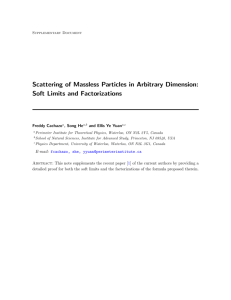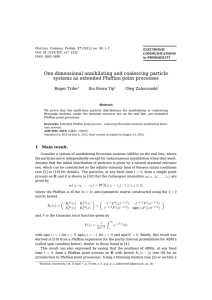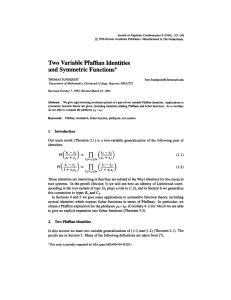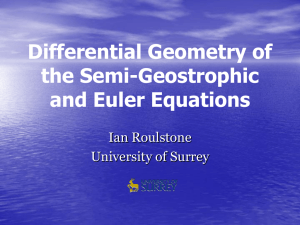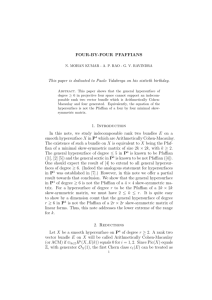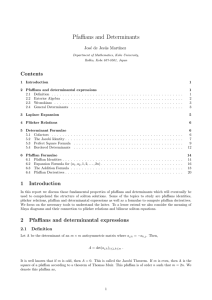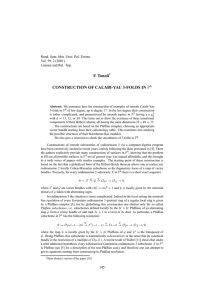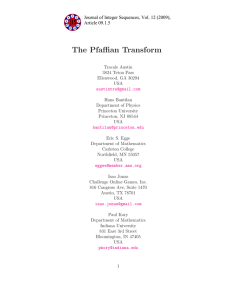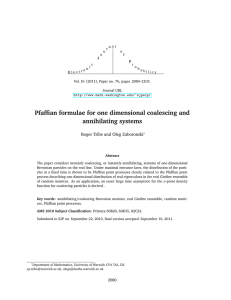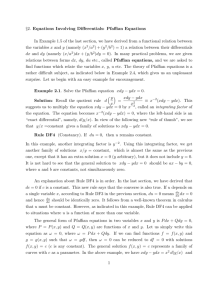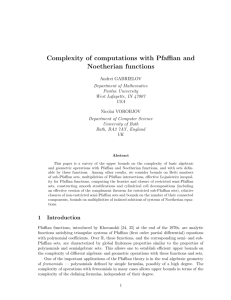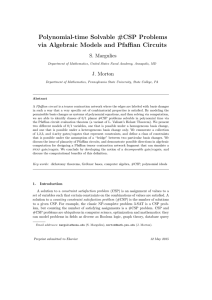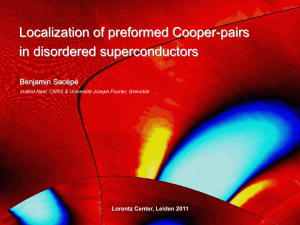A quest for Pfaffian
advertisement
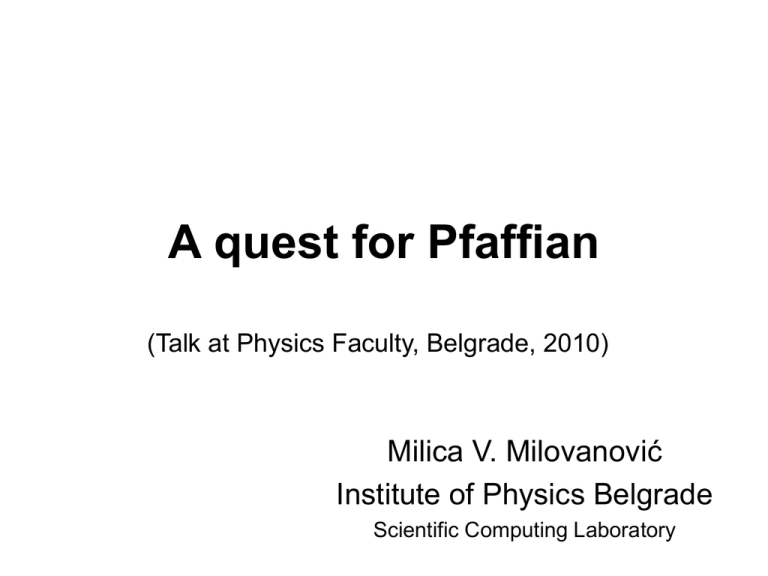
A quest for Pfaffian (Talk at Physics Faculty, Belgrade, 2010) Milica V. Milovanović Institute of Physics Belgrade Scientific Computing Laboratory Hall experiment: J.P.Eisenstein and H.L.Stormer, Science 248,1461(1990) T= 85mK Plateaus ! Rigidity ! filling factor = Ne / N In rotationally symmetric gauge in two dimensions: z x iy Single particle wave functions: m z e Orbits at radius: 1 2 |z| 4 m 0,, N 1 r 2 2m Imagine that we are at the middle of the plateau at 1/3 How the ground state of the system would look like? Laughlin answer: R.B. Laughlin, PRL 50, 1995 (1983) (z z ) i j m e 1 4 |z i |2 i j m3 Ne 1 N 3 antisymmetry and in the cases of other “hierarchical constructions” odd denominator expected! FQHE at 5/2 ! R. Willet et al., PRL 59, 1776, 1987 W. Pan et al.,PRL 83, 3530 ,1999. Theoretical Moore-Read answer: G. Moore and N. Read, Nucl. Phys. B 360, 362 (1991) 1 1 2 (z i z j ) A i j ( z z ) ( z z ) 1 2 N 1 N e e Pfaffian Pfaffian part describes a pairing among particles as in a superconductor = BCS pairing of spinless fermions Pfaffian for 4 particles: 1 1 1 1 1 1 (z1 z 2 ) (z 3 z 4 ) (z1 z 3 ) (z 2 z 4 ) (z1 z 4 ) (z 2 z 3 ) p-wave superconductor (p-ip) 1 lim|k|0 k ~ k x i k y lim|z| g (z) ~ z pairing function wave function of a pair Effective theory of a p-wave superconductor | k | 0 N. Read and D.Green, PRB 61,10267(2000) i.e. BCS mean field theory for K eff 1 k c k c k k c k c k k c k c k 2 k k2 k k , k 2 m k eigenfunction of rotations in k ~ k x i k y for eigenvalue k 1 Excitations by Bogoliubov: Ek 0 Ground state 0 k | k | 2 2 a gapped system e 1 2 k g k ck ck | 0 1 1 gk ~ g( r ) ~ kx i ky z “weak pairing” should not be too large: | k |2 Ek k 2 If large: (a) then likely: (b) k0 k kF local maximum local minimum i.e. Fermi liquid phase FQHE systems (a) 5/2 : numerics favorable for Pfaffian in 2nd LL Pfaffian is the most simple ansatz if not only explanation of plateau, R.H. Morf, PRL 80, 1505 (1998), E.H. Rezayi and F.D.M. Haldane, PRL 84, 4685 (2000) (b) 1/2 : exps. and numerics find Fermi-liquid-like phase (no plateau), E. Rezayi and N. Read, PRL 72, 900 (1994) at 1/2 (1/4) in WQWs (wide quantum wells): signatures of FQHE – minima in xx ! J. Shabani et al., Phys. Rev. Lett. 103, 256802 (2009) likely nature of these states is multi-component (two-component) theory (mathematical identity) A(331 ) Pf two-component: 331 (zi z j )3 (w k w l )3 (z p w q ) i j k l p q Pf state can lead to a first topological quantum computer! We want to know how to make Pfaffian! 331 Pf ? tunneling( t ) FL F eff BCS formalism of 331: 331 Pf with tunneling t k k t chemical potentials of parts: even: t odd: t eff t grows with tunneling! FL F eff BCS formalism of 331: 331 Pf t likely outcome: Fermi liquid If t(c c c c ) t(c c )(c c ) i.e. an open system then we may have a path: eff with Pfaffian outcome How to recognize Pfaffian? Pfaffian makes a topological phase! X.-G. Wen, Int. J. Mod. Phys. B 6, 1711 (1992) What are the signatures of a topological phase? (a) gap (b) characteristic degeneracy of ground state on higher genus surfaces like torus Torus Create a qp-qh pair, separate and drag in opposite directions along one of the two distinct paths of torus and annihilate: a global process Cylinder: To go to the other side requires energy (gapped excitations) and we may not end up with the same ground state but a new sector FQH state: Filling factor: Degeneracy on torus: Laughlin 1/3 Moore-Read Pfafian 1/2 2 3 (331) 1/2 2 4 3 3 – number connected with quasiparticles of Pfaffian: neutral fermions and vortices of the underlying superconductor, M. Milovanovic and N.Read, PRB53, 13559 (1996) Numerics with tunneling, Z. Papic et al., arxiv:0912.3103 331 Pf ? FL Sphere; overlap with tunneling: Sphere is biased for Pfaffian. in a bilayer Torus; ground states with tunneling: No (clear) signatures of 3(2) Pf degeneracy (2 – trivial degeneracy in a translatory invariant QH system at ½) The quest for Pfaffian goes on!
